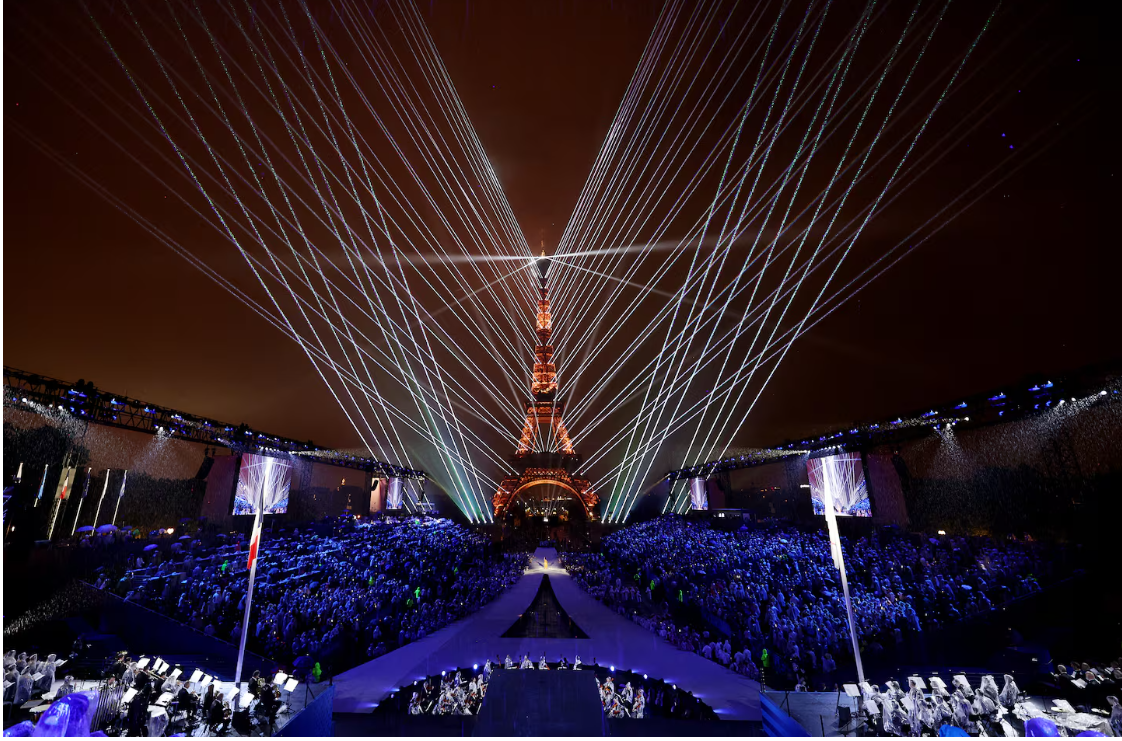巴黎克服重重困难,举办了一场向体育和文化致敬的开幕式

【中美创新时报2024 年 7 月 26 日编译讯】(记者温友平编译)在埃菲尔铁塔雄伟的阴影下,在巴黎寒冷的夜晚的雨滴中,2024 年夏季奥运会于周五正式开幕。《波士顿环球报》记者塔拉·沙利文(Tara Sullivan)对此作了下述报道。
在埃菲尔铁塔雄伟的阴影下,在巴黎寒冷的夜晚的雨滴中,2024 年夏季奥运会于周五正式开幕。一场前所未有的开幕式沿着塞纳河漂流而下,河岸上色彩缤纷、灯光璀璨、歌舞升平,所有这些都是为了迎接成千上万乘坐指定船只从他们身边漂过的国际运动员。
多年的筹划、数月的排练、资金、人力、信念,所有这些因素都汇聚在一起,为首次在传统体育场之外举办开幕式付出了非凡的努力,电视机上闪现的画面无疑反映了法国人所钟爱的盛况、欢乐、趣味和高调的滑稽。
但即使奥林匹克旗帜穿过大桥,在特罗卡德罗广场升起,即使数十支合唱团唱起奥林匹克会歌,旗帜被拉向天空,即使夜幕降临,激动人心的圣火点燃仪式即将结束,它也被其他更严重的阴影所笼罩。从清晨对巴黎高铁线路的协同攻击(包括故意纵火,法国官员认为这是为在周五晚上的仪式前扰乱交通而进行的),到超过 35,000 名军人和安保人员的出现,将巴黎变成了一个封闭的安全区,这些电视画面并没有完全展现出巴黎为实现这一切所经历的一切。
巴黎付出了高昂的代价,似乎决心与众不同,展示其独特的个性和持久的韧性,履行“永不沉没”的国家座右铭,即使这意味着提前数周将河流周边地区隔离。
这场演出确实使出了浑身解数,整晚都在向《悲惨世界》和《红磨坊》等著名的法国音乐剧致敬,还有向珍贵的法国地铁、道路和桥梁致敬的特技表演,Lady Gaga 的歌曲和无头玛丽·安托瓦内特的雕像,船上装满了不同国家队制服的美丽调色板,包括身着 Ralph Lauren 服装的美国队队员,他们忙着分享雨水淋湿的自拍照。
主办方将这种精神称为“开放的比赛”,法国人描述了他们希望当晚活动的目的是“邀请全世界一起来体验独特的情感;将体育运动从其惯常的局限中解放出来,为奥运会带来现代气息和大胆精神;与尽可能多的人创造共享时刻。”
在河上举办活动?这是一种打破常规的好方法。但也有风险,尤其是对那些亲临现场的人来说,他们每次只能看到一小部分比赛,然后比赛就结束了,就像参加游行一样。对于那些无法亲临现场的人来说,据报道,一些住在塞纳河畔的当地居民因安全问题被拒之门外。甚至对运动员来说,他们可能在塞纳河上享受了前所未有的视角,但却没有机会像过去那样在一个赛场上齐聚一堂。
尽管如此,派对仍在继续,路障内喧闹喧嚣,路障外却异常安静空旷,两个地方都在讲述法国的故事。这就是创意领袖托马斯·乔利的愿景,他是一位屡获殊荣的戏剧导演,他希望以这座城市本身作为背景,通过标志性建筑讲述这座城市的故事,例如埃菲尔铁塔、巴黎圣母院和卢浮宫,所有这些建筑都在演出中扮演了主角,同时也通过其在艺术领域的全球影响力,从世界上最受关注的法语艺术家、流行歌星中村绫到深受喜爱的隐居歌手席琳·迪翁,席琳·迪翁从疾病和声音问题中凯旋归来,以一场精彩的表演结束了当晚的演出。
就像国家的两大支柱一样,体育和艺术支撑了整个夜晚。包容性也同样重要,不仅体现在沿着河流划分的 12 个场景中,面孔、声音、舞蹈、时尚和音乐的多样性令人信服。
法国向本国最伟大的运动员致敬,从前头号网球运动员阿梅莉·毛瑞斯莫到 NBA 冠军托尼·帕克,再到世界杯足球赛冠军齐内丁·齐达内,他们都在当晚的最后时刻共同接过奥运火炬。但我们也看到了西班牙网球明星拉斐尔·纳达尔,他在罗兰加洛斯红土上的出色表现为他赢得了法国荣誉地位,并有机会从齐达内手中接过火炬。还有网球名将塞雷娜·威廉姆斯,她和他们一起乘船将火炬运送到最终目的地——一个巨大的漂浮热气球。
热气球升空,标志着仪式结束,奥运会正式开始。巴黎市沉浸在成功举办这一历史性盛会的喜悦之中。在长达四个小时的奥运庆典中,在红、白、蓝三色的水柱中,在曾被烧毁的巴黎圣母院重新响起的钟声中,在挥舞着国旗、脸上涂满颜料的欢乐球迷的陪伴下,那些阴影虽然只是暂时地从视野中消失了。
题图:在巴黎开幕式上,激光照亮了埃菲尔铁塔周围的天空。JAMIE SQUIRE/GETTY
附原英文报道:
Paris navigates many challenges to put on an Opening Ceremony honoring sports and culture
By Tara Sullivan Globe Staff,Updated July 26, 2024
PARIS — Under the majestic shadow of the Eiffel Tower, amid the raindrops of a chilly Paris night, the 2024 Summer Olympics officially began Friday. An Opening Ceremony unlike anything the world has ever seen floated its way down the River Seine, with an explosion of color, of light, of dancing and singing taking place along the river’s banks, all of it designed to greet the thousands of international athletes who floated past them nation by nation, in their assigned boats.
The years of planning, the months of rehearsal, the money, the manpower, the belief, all of it came together in the extraordinary effort to stage the first Opening Ceremony outside the traditional stadium setting, and the images that flashed across television sets certainly reflected the pageantry, joy, fun, and high camp silliness the French love so well.
But even as the Olympic flag made its way across the bridge to be raised at the Trocadero, even as it was pulled to the skies as the Olympic anthem was sung by dozens of choirs, even as the night moved toward its stirring flame-lighting conclusion, it was covered in other, more serious shadows, too. From an early-morning coordinated attack on the city’s high-speed train lines, which included deliberate arson that French officials believe was done to disrupt travel ahead of Friday night’s ceremony, to the excess of 35,000 military and security personnel whose presence turned the city into a locked-down security zone, those television images did not tell the full story of what the city went through to make it all happen.
Paris paid a high price, determined, it seemed, to be different, to show off both its unique personality and its enduring resilience, to live up to a national motto that speaks of being unsinkable, even if that meant isolating the area around the river for weeks in advance.
The show certainly pulled out all stops, a nightlong homage to famous French musicals such as “Les Misérables” and “Moulin Rouge”, stunts that honored treasured French subways, roads, and bridges, songs from Lady Gaga and a headless Marie Antoinette, boats filled with the beautiful palettes of different national uniforms, including the Ralph Lauren-clad Team USA, busy sharing rain-soaked selfies.
With an ethos dubbed by organizers as “Games Wide Open,” the French described their intention for the evening’s event to be “an invitation to the whole world to come and experience unique emotions together; to bring a breath of modernity and boldness to the Games, by taking sport out of its usual confines; to create shared moments with as many people as possible.”
Putting the event on a river? Not a bad way to break out of usual confines. But there was risk, especially for those attending in person, who could only see small portions of the event at a time before it moved from view, like being at a parade. Or those who couldn’t, with reports of some local residents with apartments on the Seine shut out of their own residences over security clearance concerns. Or even for athletes, who may have enjoyed the unprecedented viewpoint as they moved down the Seine, but were not afforded the chance to unite on one field, as has been the norm in the past.
Still, on the party went, loud and raucous within the barricades, eerily quiet and empty beyond them, a story of France told in both locations. Such was the vision from creative leader Thomas Jolly, an award-winning theater director who wanted to use the city itself as his backdrop, to tell its story through iconic architecture such as the Eiffel Tower, Notre Dame Cathedral, and the Louvre, all of which had starring roles in the show, but also through its worldwide impact in the arts, performances from the most-listened-to French-speaking artist in the world, pop star Aya Nakamura, to one from the beloved and reclusive Celine Dion, who made a triumphant public return from illness and voice problems to close out the night with a beautiful performance.
Like twin pillars of the nation, sports and the arts carried the night. As did inclusion, and not only in the compelling diversity of faces, voices, choreography, fashion, and music performed along the 12 tableaus sectioned along the river.
France honored its own greatest athletes, from former No. 1 tennis player Amelie Mauresmo to NBA champ Tony Parker to World Cup soccer champion Zinedine Zidane, who were among those sharing possession of the Olympic torch toward the end of the night. But, we also saw Spanish tennis star Rafael Nadal, whose excellence on the red clay of Roland Garros earned him honorary French status and the chance to take the torch handoff from Zidane. And there was fellow tennis great Serena Williams, joining them on the boat ferrying the flame to its final destination of a giant, floating hot air balloon.
Off it went, marking the end of the ceremony and the official start of the Games. The city of Paris basked in the glow of having pulled off such a historic event. Across four hours of Olympic celebration, amid plumes of red, white, and blue water, through the renewed chimes of the once-burned Notre Dame, past the flag-waving face-painted joy of fans, those shadows, if just temporarily, faded from view.

